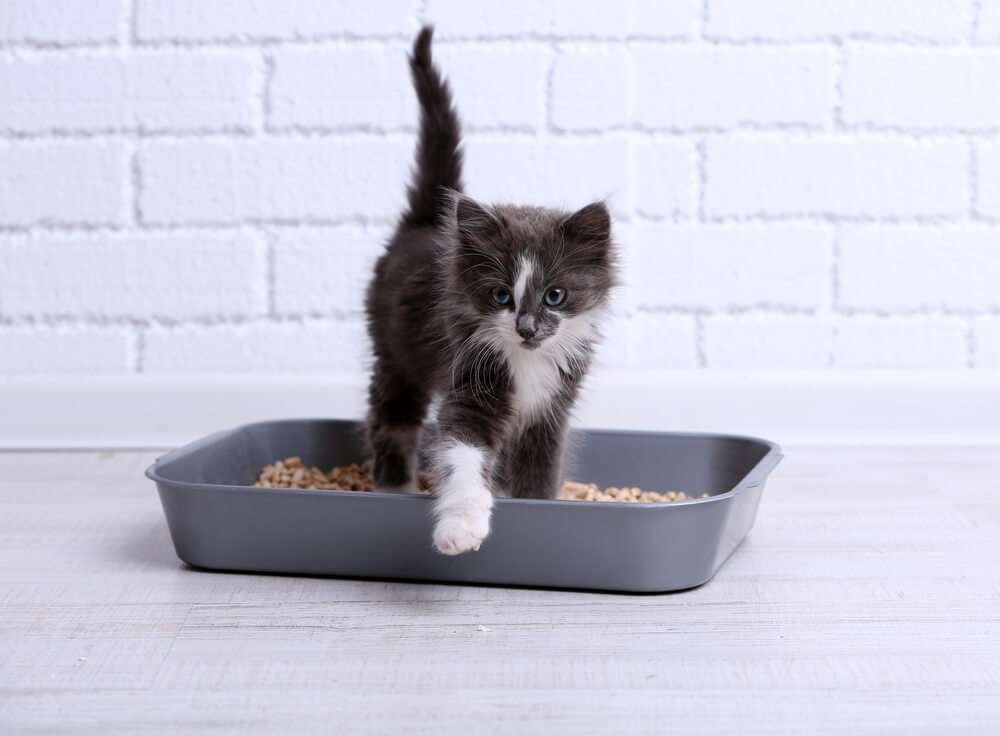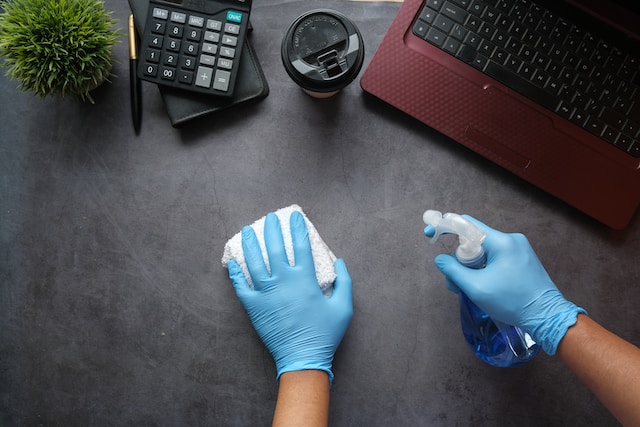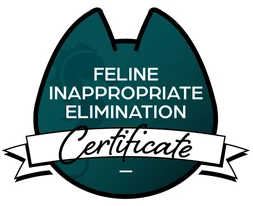As a litter box usage expert, I spend a lot of time talking with clients about cleaning cat pee when their cats aren’t peeing in their litter box. It’s a frustrating process at times as cat urine isn’t exactly a pleasant smell. If done incorrectly, it can even make the problem worse or not get the odor out. It benefits you in multiple ways to make sure you clean up any urination outside the litter box correctly, rather than just using any old method.
I’ve put together this guide on best practices to help cat parents clean cat urine when needed on a variety of surfaces. The most important step to cleaning cat pee, however, is figuring out why your cat isn’t using the litter box. If you you haven’t already taken your cat to a veterinarian, I suggest starting there. Many medical problems can cause behavior change in cats so you want to make sure that is ruled out. If you’re still having trouble with getting your cat to use their litter box, a behavior consultation with me is a great next step.
Why Does Cat Pee Smell So Bad?
Cat urine is a pretty awful smell. Before I began studying cat behavior, I fell victim to a type of litter that claimed you only needed to scoop poop and could just change the litter once per week as it absorbed the urine odor. I now know better than to use those types of litters as they’re not appealing to cats, but at the time that prospect seemed pretty great.
Unfortunately, when I did go to change the litter after the first week, I was in for an extremely unpleasant surprise. As soon as I started dumping the used litter into the trash, the urine soaked particles became exposed. Even though I followed directions about stirring the litter, it was one of the worst smells of my entire life. I almost vomited from how putrid it was. Looking back, I feel awful for poor Zoloft who probably was able to smell it even prior to that. He put up with so much from me!
I was pretty quickly back to regular old unscented clay clumping litter at that point and with regular scooping and cleaning, my litter box has remained low odor. So why did I find the smell of cat pee so revolting? It ultimately comes down to the presence of sulfur in a urine metabolite called felinine. This metabolite, as you would correctly assume, is present in cat urine.
Why Does The Smell Return After Cleaning?
Of course, there are other components of cat pee that contribute to the lingering smell. Uric acid is one of the more problematic components of cat urine as it will often linger in materials a cat has peed on after attempts at cleaning. When combined with moisture, such as if it’s particularly humid, the smell will get reactivated.
Even if you don’t smell it, your cat will and part of how your cat decides where to pee is based on scent. If they catch a whiff of uric acid when they have to go, it may remind them that they peed there. The result? Your cat decides to top it off with some fresh urine. Thanks for that, Fluffy.
It’s really, really important that you make sure all uric acid is completely removed when you are cleaning up after your cat pees outside the litter box. Failure to do so will result in the smell returning for you and your cat which may perpetuate the problem.

Which Products To Use To Clean Cat Urine
Hopefully, you can see why you can’t just get soap, water, and a towel to clean up your cat’s urine as they likely won’t tackle the problematic molecule that causes the unpleasant smell. In order to correctly clean cat urine, you’ll need to use a product that actually tackles the cat urine. A general-purpose cleaner, bleach, or soap and water may work well for other messes, but for cat urine, they likely may not be enough. In the case of bleach, it’s actually a really bad idea to try to clean cat urine with it.
There isn’t one specific product that is better than others, but there are some things you can look for to help you select a good one. Let’s go over what makes a cat urine cleaner work.
It Has Urine Destroying Enzymes
The product I’ve found has the best results with clients is Angry Orange’s enzymatic cleaner, though Roxie and Rocco also make an excellent enzymatic cleaner. Both contain enzymes that break down the uric acid found in cat urine and gets rid of the source of the problem. Finding an enzymatic cleaner is going to help so much when it comes to effective cleaning so prioritize a product that has cat urine-specific enzymes in it.
Of course, some products may vaguely claim to have enzymes but still not be great. Avoid general cleaners or products specific to dog urine. You also want to go for a professional strength product to make sure it will be concentrated enough to eliminate the uric acid. You can try a product that is for both cats and dogs, but make sure that cats are specifically mentioned on whichever product you use.
If something doesn’t have enzymes in it, it might help with the odor. For example, an oxidizing urine cleaner or general pet odor eliminator might remove a stain or make it so the smell is less strong when you sniff it. However, it may not completely remove all the uric acid. They can still be a great supplement to an enzymatic cleaner to knock out that last bit of odor.
Buy From A Reliable Source
The enzymes in products used to clean cat pee can degrade over time. Because of this, you don’t want to buy in bulk unless you’re going to use it all at once. That also means you want to make sure wherever you’re getting it from is a legitimate source. For example, when purchasing Angry Orange on Amazon, I suggest getting it from the official Angry Orange store rather than another seller. The other sellers may have old product that’s been sitting in a warehouse. Not what you want!
If you’re not sure if you trust a big box store, just go straight to the source. Angry Orange, as an example, allows you to purchase cleaners directly from their website. You know you’ll get the fresh stuff that way.
Best Practices For Cleaning Cat Pee
Now that you’ve got your cleaning product, you can just dump it on your carpet and be done with it, right? Not so fast. Cleaning cat pee requires different techniques depending on what material your cat peed on and how old the stain is. We’ll go over some of the more common surfaces so you have the best chance of completely eliminating the urine, but first let’s go over some general tips.
General Cleaning Process
If possible, test any cleaning product in a hidden location so you can make sure it doesn’t damage the material you’re trying to clean. While getting the scent out is great, if you trade the stain for discoloration then you’re just substituting on problem for another.
The sooner you begin cleaning, the better. This prevents the urine from soaking into the material you’re going to clean and allows you to soak up some of the still-fresh urine. Gently blot up any urine from the outside inward and then spray a small amount of the urine cleaner in the center of the stain. Be careful not to overdo the amount of cleaner you use as you don’t want to accidentally spread the urine.
Let the cleaner soak for the amount of time suggested by the manufacturer at a minimum, though you may want to let it sit there for longer to really get out stains. Blot up the cleaner and repeat at least once. For items that can go in the laundry like clothing or a washable rug, soaking them overnight in diluted urine cleaner may help remove the stain and odor. If your urine cleaner is safe to go into the laundry, you can add a very small amount to help further destroy any lingering pee.
Once the scent and visible stain are gone, do one more cleaning. Why? To really make sure you get the uric acid destroyed as outlined above. Because cats have a better sense of smell than us, it may not be completely gone so you really want to make sure you are getting as much of it cleaned out as possible. You will benefit from repeated cleanings!

Things To Avoid
To make sure you are actually cleaning the cat pee and not spreading the cat pee, you want to be cautious with what you do. I don’t recommend taking water and dumping it on the spot as this will just spread the urine to more of whatever material it is on. It may also make it go deeper into the fabric.
When doing the actual cleaning, you want to gently blot up any urine or cleaner you use rather than pushing it in. If you push it in too hard, you may drive some of the urine deeper into the material. Better yet is letting the urine soak up using an old towel so you don’t do any pushing or rubbing, but this may not be possible for older stains.
Cleaning Furniture and Mattresses
Cleaning cat urine out of soft furniture such as mattresses, couches, and chairs is a particular challenge depending on where your cat peed and how soaked in the urine got. If possible, remove any upholstery and launder it per the care instructions for the fabric. You can soak it in a diluted urine destroyer as outlined above, though remember to test a small patch of it first.
Depending on what is inside the furniture or what material the mattress is made from, you may need to do some extra work to get the urine out if it soaked into the inner parts of the item. Simply spraying the foam or outer upholstery fabric with a cleaner may not get to urine that penetrated deep into the mattress. Instead, you may want to use something like a large bore needle to inject the cleaner right into the foam of your couch or mattress. You’ll likely need to do multiple injections in different locations.

If the urine gets onto any wooden parts, you’ll want to follow some of the tips on cleaning wood outlined next. You may need to consider having the wood refinished or having that part replaced. Depending on the material, any metal parts may need to be sprayed with a urine cleaner that can sit for a little while before being completely wiped up. You don’t want to leave liquid sitting in a place that could cause rust.
Cleaning Cat Urine From Flooring
If you have hardwood or carpet floors and your cat is peeing on the floor, there can be a few extra steps you need to take to completely remove the urine. For both of them, you want to make sure the urine didn’t get down below the surface as that may require a professional to help clean or replace the flooring.
Rugs
Some cats seem to have a thing for peeing on rugs even more than they do carpets. Rugs can be made of materials that make them hard to clean so if you have an heirloom rug or something that isn’t easily washable, put it away until you address the underlying issue to stop the urination.
One option to use either permanently or temporarily is getting a machine-washable rug. It can take a long time to do all the washing yourself so just tossing it in the washer saves you time. In fact, you can use a machine-washable rug to cover places you don’t want the cat to go as a way to contain the problem. I really like My Magic Carpet rugs as they come in a variety of different patterns to fit your preferences and they’re easy to wash should they become soiled.
Carpet
Cleaning carpet is a very similar process to the general cleaning guidelines, but you also have the option of using a power cleaner. Make sure you use a urine specific cleaner that is compatible with the machine you’re using. If possible, an enzymatic cleaner is your best choice as long as it can be used in a power cleaner. Be cautious to not spread the urine by using too much water!
One way to consider using the power cleaner would be to do a nice soak of the carpet stain using the enzymatic cleaner, letting it sit overnight, and then using the power cleaner the next day. This may reduce the amount of urine that gets spread as you should have removed a lot of the uric acid already.
Worst case scenario? Consider hiring a professional. Make sure you’ve addressed the underlying reason why your cat is urinating outside the litter box first or they may just go pee on your freshly cleaned carpet. I also suggest you make sure the company you hire knows how to clean cat urine. Make sure they are using a product specific to cat urine as it absolutely is necessary that they use the right urine-destroying product. I’ve had clients hire cleaners before who told them this was not necessary initially! Don’t be afraid to ask questions.
Wood
Wood comes with the extra challenge of it can become warped or discolored due to the moisture in the urine. Plus, it can also cause rot and mold. You’re trading one gross problem for another gross problem. Worse yet, the cat urine and uric acid may get stuck in the wood itself. Many urine specific cleaners require at least some soaking to work so you have a lot of competing needs to balance.
While it can be challenging, you can attempt to clean the urine out of the wood if you use a lot of caution. Start by wiping up any fresh urine as soon as possible and removing anything (like a litter box) that may be soaked in urine or hiding urine under it. You can wipe down the area with a small amount of an enzymatic cleaner and then let it dry. Once it’s completely dry, spray the cleaner and let it soak for the minimum time suggested by the manufacturer (usually 15 minutes) and then wipe it up. Let it dry completely and repeat.
The key here is you need to let the cleaner soak very briefly and then let it be completely dry before wiping it up right away. This process still may cause warping or discoloration so try it at your own risk!
Likely, you’ll end up needing to get the wood refinished. I suggest waiting until the cause of the urination (whether a medical or behavioral problem) is solved before refinishing your floors. Similar to installing cat shelves into your walls, unless you know what you’re doing, this is something I strongly advise you leave to a professional.
What If My Attempts At Cleaning Cat Pee Don’t Work?
If you’ve tried the above methods and still can smell the cat urine or the stain is still present, you may want to do some troubleshooting. Here are some quick tips to see if they are contributing to poor results.
- Check the cleaner you are using. Make sure it’s not expired and that you’re following the directions. Also make sure you are using enough of the cleaner and that it’s appropriate for the surface you are trying to clean.
- Try a different product or method. While I find Angry Orange to work for many clients, some clients haven’t found it helpful. There are other cat urine cleaners available so sometimes you just need to try a different product to get different results. Similarly, maybe you do need to use a power cleaner to really get the stain out.
- Make sure your cat isn’t “topping it off.” I hope this one is obvious, but make sure your cat isn’t going back and peeing in that location while you aren’t looking. I suggest setting up a video camera that is motion activated and can record as even if your cat is using their litter box sometimes, they may still be peeing in that spot later.
- Consider hiring a professional. Hiring a knowledgeable professional who has experience in cleaning cat pee is a great idea and will be less frustrating for you.
Cleaning Cat Urine Is Challenging
Clearly, there are a lot of things to think about if you find yourself cleaning cat urine outside the litter box. It can take time, repeated cleanings, and effort to get the smell to go away. Plus, even if you get the smell to go away, if you don’t clean correctly your cat may still smell the urine leading to a repeated cycle of cleaning cat pee over and over. That’s no fun at all!
If your cat has urinated on something you’re not particularly attached to or you’ve been thinking about replacing anyway, you may want to ask yourself if it’s worth going through the effort of cleaning whatever it is. The same goes for if it is a material that is unlikely to be successfully cleaned or something that has no sentimental value to you. There’s nothing wrong with tossing something rather than driving yourself mad with unsuccessful attempts to clean.
For things like carpet and flooring, once you’ve gotten your cat using the litter box again you may want to consider a full replacement of the carpet or flooring. There will always be a little bit of cat urine left behind even if you clean correctly and use the right products so the only real way to get 100% of it gone is to replace it. This isn’t taking the easy way out or being lazy. It’s just being practical!










